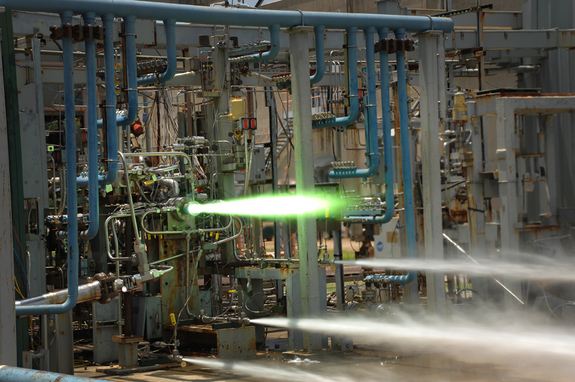It looks like you're using an Ad Blocker.
Please white-list or disable AboveTopSecret.com in your ad-blocking tool.
Thank you.
Some features of ATS will be disabled while you continue to use an ad-blocker.
4
share:

Key rocket parts built using 3D-printing technology have passed another round of NASA firing tests, inspiring further confidence among space agency officials in this emerging manufacturing technique.
Rocket parts created using a 3D printer were successfully tested and were proven to be similar to rocket parts not created by a 3D printer. Which has inspired NASA to use 3D printing in the future.
"The additive manufacturing process has the potential to reduce the time and cost associated with making complex parts by an order of magnitude," Singer said.
Which reduces prices and time in creating the parts and what not.
I find this to be amazing and I would love for NASA to use 3D printing to their advantage and reinvent space exploration.
Source
Although I am excited at all of the possibilities and potential of this exciting (relatively) new technology. I am weary of this technology in its
current state. From the few demonstrations of applicable 3D printing I have seen (ie. the firearm that failed after a few rounds), it has to be
significantly improved prior to being implemented in cost extensive programs associated with space exploration. As always, when it comes to progress
and innovation of developing technological advancements, I am sure in due time this will be achieved. In the meanwhile, I would recommend being
cautiously optimistic and not push this technology to its bounds just yet (ie. avoiding manned missions utilizing 3D printed parts for at least a
couple decades).
edit on 7/27/2013 by Pistoche because: Fixing errors and typos.
At the same time, however, the potential possibilities of this technology are vast. Think about it like this;
A crew of astronauts are in the space station at the time of some kind of collision with the ISS. Perhaps it was small, but a significant piece of equipment was badly damaged and they need a fix now. Imagine it was a part in the oxygen supply system. Well, instead of waiting for a spare part to be flown up and then utilized, they can (depending on the size of the part) print it out in space and install it much more quickly!
Not to mention the printing of new tools and etc. on the space station.
However, this kind of thing can also go incredibly wrong.
Two examples;
If there is an Internet Connection and someone manages to hack into the default setup of that printer, causing it to go ever so slightly askew, in a way not noticeable to the human eye, what happens when that faulty part is installed? Further damage cause?
Another possibility (very highly unlikely) is that someone prints up a firearm/weapon in space and hijacks the ISS (again, possible, but highly unlikely).
Regardless, I think it is an exciting new avenue for technology and design and I cannot wait to see where it takes us!
A crew of astronauts are in the space station at the time of some kind of collision with the ISS. Perhaps it was small, but a significant piece of equipment was badly damaged and they need a fix now. Imagine it was a part in the oxygen supply system. Well, instead of waiting for a spare part to be flown up and then utilized, they can (depending on the size of the part) print it out in space and install it much more quickly!
Not to mention the printing of new tools and etc. on the space station.
However, this kind of thing can also go incredibly wrong.
Two examples;
If there is an Internet Connection and someone manages to hack into the default setup of that printer, causing it to go ever so slightly askew, in a way not noticeable to the human eye, what happens when that faulty part is installed? Further damage cause?
Another possibility (very highly unlikely) is that someone prints up a firearm/weapon in space and hijacks the ISS (again, possible, but highly unlikely).
Regardless, I think it is an exciting new avenue for technology and design and I cannot wait to see where it takes us!
new topics
-
Russia Flooding
Other Current Events: 1 hours ago -
MULTIPLE SKYMASTER MESSAGES GOING OUT
World War Three: 1 hours ago -
Two Serious Crimes Committed by President JOE BIDEN that are Easy to Impeach Him For.
US Political Madness: 2 hours ago -
911 emergency lines are DOWN across multiple states
Breaking Alternative News: 2 hours ago -
Former NYT Reporter Attacks Scientists For Misleading Him Over COVID Lab-Leak Theory
Education and Media: 4 hours ago -
Why did Phizer team with nanobot maker
Medical Issues & Conspiracies: 5 hours ago -
Pro Hamas protesters at Columbia claim hit with chemical spray
World War Three: 5 hours ago -
Elites disapearing
Political Conspiracies: 7 hours ago -
A Personal Cigar UFO/UAP Video footage I have held onto and will release it here and now.
Aliens and UFOs: 7 hours ago -
Go Woke, Go Broke--Forbes Confirms Disney Has Lost Money On Star Wars
Movies: 9 hours ago
4
